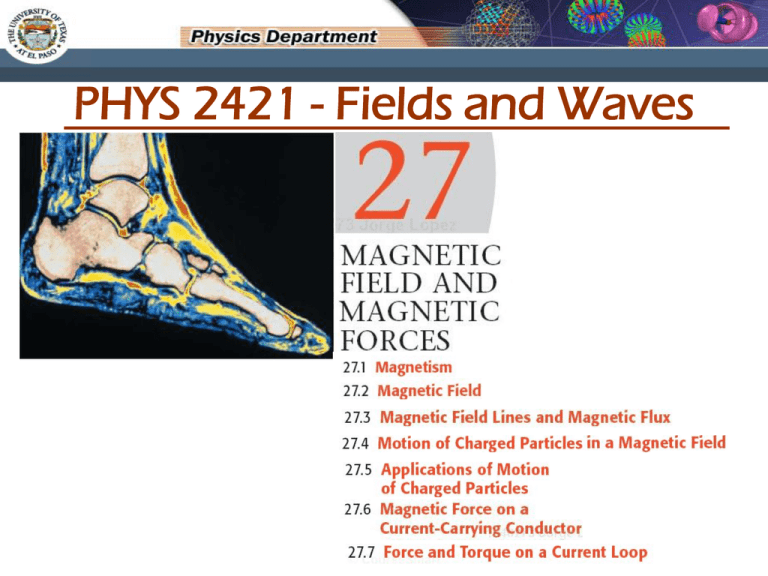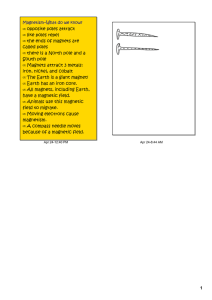Magnetism, Magnetic Field
advertisement

PHYS 2421 - Fields and Waves Magnetism: the idea Remember Coulomb’s law: q1 F F r q2 F =k q1q2 r2 Now put q1 in motion q2 feels a force changing in magnitude and direction This is the origin of magnetism and it is produced by moving charges and affect only moving charges PHYS 2421 - Fields and Waves In chapter we will study: • Permanent magnets • Magnetic fields • Effect of magnetic fields • on charges • on currents • on loops (torque) Background: • 1st record of magnetic iron ore appeared in Magnesia 2500 years ago • Shen Kuo was the first scientist to use magnetic needles in navigation • H.C. Ørsted studied relation between electricity and magnetism, followed by Ampere, Gauss and Faraday. • Maxwell synthesize his equations combining electricity and magnetism • Einstein’s theory of relativity show that electricity is the same as magnetism in a different frame of reference A few facts: • Magnets have poles, usually called north or south • Equal poles repel, unequal poles attract • Magnets attract some un-magnetized metals • There are no single poles • Ørsted: electric currents deflect compasses like magnets • The earth has a magnet but its N and S are opposite to the geographical north and south Remember the electric case Follow a similar approach for the magnetic case A few facts: •A moving charge creates a magnetic field •The magnetic field, B, exerts forces on other moving charges •The force is given by F qv B where v is the velocity of the moving charge •The magnitude is given by F q vB sin where is the angle between V and B •The units of the magnetic field are F N N N Tesla B qV C m/s m C/s Am Some examples F qv B F q vB sin F 1.6 1019 C 3 105 m/s 2 T sin 300 4.8 1014 N In negative y direction Homework : Problem 27.1 and 27.7 (11th Ed.) or 27.1 and 27.5 (12th Ed.) Summary of Section 27.2 The force produced by a magnetic field B on a charge q moving at velocity is: F qv B Its magnitude is: F q vB sin N and B is measured in units of: Tesla Am Hmwk Section 27.2: Problems 27.1 and 27.7 (11 th Ed.) or 27.1 and 27.5 (12th Ed.) In electric case E and F are parallel or antiparallel F qE In the magnetic case B is always perpendicular to F F qv B Thus, the magnetic B lines are not “force lines Some examples of direction of B fields More examples of direction of B fields Notice that all B lines close on itself Now calculate magnetic flux over an area A: B B A For closed surfaces, since all B lines close on itself, the flux will be zero B B dA 0 Magnetic version of Gauss law Units: Weber Wb = T x m2 B B A BA cos600 B 0.9 103 Wb B 6T 0 4 2 A cos60 3 10 m 0.5 Homework : Problems 27.11 and 27.12 (11th Ed.) or 27.11 and 27.12 (12th Ed.) Soln P. 12: a) 0, b) -0.0115Wb, c) b) +0.0115Wb d) 0 Summary of Section 27.3 B field lines Magnetic flux B B A B B dA 0 Hmwk Section 27.3: Problems 27.11 and 27.12 (11 th Ed.) or 27.11 and 27.12 (12th Ed.)



